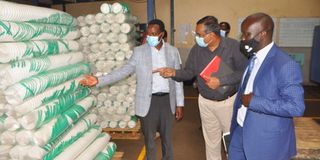UDB needs Shs700 billion to finance appraised projects

S. Sivakumar, the chief executive officer Afroplast Enterprises, shows African Development Bank Uganda officials the products produced using the equipment that was purchased using the loan from the bank. UDB follows certain criteria in giving out loans to ensure that funds will be repaid to fund other viable projects. PHOTO/STEPHEN OTAGE
What you need to know:
As attempts at resuscitating the economy continue building up, the private sector still needs to access affordable and long-term credit lines, to propel investments, expansion of production lines and services. In an interview with Prosper Magazine, Samuel Sedem-Maitum, Uganda Development Bank’s director for credit says Shs444 billion of the Shs455 billion economic stimulus intervention fund from the government has already been committed to various projects? But the development lender now needs at least Shs709 billion to finance already appraised projects.
How is Uganda Development Bank, reaching out to enterprises and potential projects in desperate need of financial services?
UDB will continue utilising various avenues to create awareness about the opportunities for collaboration and funding. We shall undertake regional business forums across the country to sensitise the business community and source business opportunities.
As a development lender, we shall continue to issue and refresh the call for applications for sector interventions with the public from time to time.
There will be continued engagement with organised associations (Small & Medium Enterprises, umbrella bodies, Women and Youth Associations) to co-create products and solutions for our customers.
Is UDB able to meet the growing demand for long-term funding by the business community with appropriate pricing?
UDB can meet the demand for long-term funding and the ever-increasing needs, because the bank has not only been capitalised but also leverages up to two times the shareholders capital which is in excess of Shs1 billion.
Some business owners continue to raise concerns on the selection and actual access to credit from UDB. What are you doing about this concern?
UDB has set out the criteria for borrowers to access the financing provided they meet the eligibility criteria and have viable projects in the targeted sectors of primary agriculture, agro-processing, tourism, infrastructure, human capital development and manufacturing.
The criteria are necessary to secure shareholder value and ensure that funds will be repaid to be utilised to fund other viable projects. The fact that there is an active pipeline of nearly Shs709 billion, attests to the demand and requirement in excess of the current available funding.
Therefore, UDB needs to ensure that viable and sustainable projects get financed to deliver on development impact.
Since the state intervention with Shs450 billion in additional capitalisation to UDB at the start of this financial year, how much ground has the bank covered?
We (UDB) received Shs455b in August 2020. So far, we have deployed the fund as follows: Shs444 billion in credit has been approved to various entities in the target sectors across the country. Out of this, Shs242 billion has been disbursed as of December 2020 of which Shs192 billion was to projects in primary agriculture, agro processing and manufacturing. The value of projects appraised and approved but not disbursed amounts to Shs351 billion based on phased disbursement/funding structure of projects.
You were required to match the additional capitalisation with an effective economic stimulus as a development lender, any outcomes so far?
UDB’s economic stimulus solution was meant to support the increase in production of essential goods and services for import replacement and export enhancement and issued the call for application to utilise the Shs455 billion capitalisation that was earmarked for this purpose.
It is partly due to the success of this call that UDB was able to approve and commit Shs444 billion in the year 2020.
There are key sectors such as manufacturing for import substitution and tourism for stability in the midst of reduced international travels. How have they been helped?
Manufacturing for import replacement has been facilitated through financial and non-financial solutions to enable purchase of equipment and machinery needed for the manufacturing process.
It has also had to do with capacity building through the construction of factory premises, working capital facilities together with business advisory and project preparation expertise.
Together with the European Union (EU), we set up a Tourism Intervention Fund (Blended solution Loan with a Grant component) to help members of the Uganda Hotel Owners Association and Association of Uganda Tour Operators cover part of their costs to enable them stay open and maintain a minimal level of employment for at least two years while the sector recovers.
As director in charge of credit, what is your appraisal of the quality of loans under the current economic environment?
There is need to accommodate a few loans in the bank’s portfolio and a few facilities have experienced decline in performance which would have normally presented a significant increase in credit risk or increased probability of default.
I anticipate that potentially the majority of businesses will adapt to the current circumstances and survive through our remediation efforts which include restructuring or modification of facilities.
We shall continue to support our clients in distress through business advisory services to assure the long-term success of the clients we finance.

What is the outlook across the major sectors you are currently supporting as a development lender?
The outlook for the Bank’s target sectors is positive. The prospects for improved performance in 2021 and beyond will depend upon the easing of restrictions following increased vaccine uptake, lower infection rates and growth in customer credit appetite.




